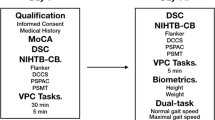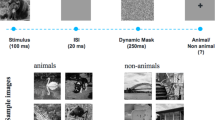Abstract
Current cognitive assessments suffer from limited scalability and high user burden. This study aimed to (1) examine the relationship between a brief eye-tracking-based visual paired-comparison (VPC) and gold standard cognitive assessments, (2) examine longitudinal stability of the VPC task, (3) determine the ability of the VPC task to differentiate between cognitively normal (CN) individuals and individuals with mild cognitive impairment (MCI). Fifty-five adults (n = 44 CN, n = 11 MCI; 56.4 ± 26.7 years) were tested on two occasions, separated by at least 14 days. Visit 1 included VPC, Montreal Cognitive Assessment (MoCA), Digit Symbol Coding test (DSC), and NIH Toolbox Cognitive Battery (NIHTB-CB). Visit 2 included VPC, DSC, NIHTB-CB, and dual-task (DT). Significant differences existed between baseline VPC scores for CN and MCI groups (p < .001). VPC scores remained stable over time in both groups (p < .05). Significant associations existed between VPC and MoCA (p < .01), DSC (p < .001), and various NIHTB-CB subtests at both time points. The VPC test significantly predicts cognitive outcomes (p < .05), with age and VPC being the only significant predictors. Additionally, area under the curve (receiver operator characteristic = 0.80) for VPC scores demonstrated good classification accuracy. VPC reliably predicted cognitive status while remaining stable over time and displayed significant associations with gold standard cognitive assessments. VPC is a less burdensome and more scalable assessment than traditional tests, enabling longitudinal monitoring of cognitive status in resource-limited environments.



Similar content being viewed by others
References
Alzheimer’s Association. 2019 Alzheimer’s disease facts and figures. Alzheimers Dement. 2019;15(3):321–87.
Best JR, Liu-Ambrose T, Boudreau RM, Ayonayon HN, Satterfield S, Simonsick EM, et al. An evaluation of the longitudinal, bidirectional associations between gait speed and cognition in older women and men. J Gerontol A Biol Sci Med Sci. 2016;71(12):1616–23. https://doi.org/10.1093/gerona/glw066.
Bott NT, Lange A, Rentz D, Buffalo E, Clopton P, Zola S Web camera based eye tracking to assess visual memory on a visual paired comparison task Front Neurosci. 2017; 11. https://doi.org/10.3389/fnins.2017.00370.
Bott N, Madero EN, Glenn J, Lange A, Anderson J, Newton D, et al. Device-embedded cameras for eye tracking–based cognitive assessment: validation with paper-pencil and computerized cognitive composites. J Med Internet Res. 2018;20(7):e11143. https://doi.org/10.2196/11143.
Brustio PR, Magistro D, Zecca M, Rabaglietti E, Liubicich ME. Age-related decrements in dual-task performance: comparison of different mobility and cognitive tasks. A cross sectional study. PLoS One. 2017;12(7):e0181698. https://doi.org/10.1371/journal.pone.0181698.
Chehrehnegar N, Nejati V, Shati M, Esmaeili M, Rezvani Z, Haghi M, et al. Behavioral and cognitive markers of mild cognitive impairment: diagnostic value of saccadic eye movements and Simon task. Aging Clin Exp Res. 2019;31(11):1591–600. https://doi.org/10.1007/s40520-019-01121-w.
Chen-Chen T, Jin-Tai Y, Lan T Biomarkers for preclinical Alzheimer's disease. J Alzheimer's Dis. 2014;42(4):1051–1069.
Crowe SF, Benedict T, Enrico J, Mancuso N, Matthews C, Wallace J. Cognitive determinants of performance on the digit symbol-coding test, and the symbol search test of the Wais-III, and the symbol digit modalities test: an analysis in a healthy sample. Aust Psychol. 1999;34(3):204–10. https://doi.org/10.1080/00050069908257455.
Crutcher MD, Calhoun-Haney R, Manzanares CM, Lah JJ, Levey AI, Zola SM. Eye tracking during a visual paired comparison task as a predictor of early dementia. Am J Alzheimers Dis Other Dement. 2009;24(3):258–66. https://doi.org/10.1177/1533317509332093.
Donohue MC, Sperling RA, Salmon DP, Rentz DM, Raman R, Thomas RG, et al. The preclinical Alzheimer cognitive composite: measuring amyloid-related decline. JAMA Neurol. 2014;71(8):961–70. https://doi.org/10.1001/jamaneurol.2014.803.
Fagan JF. Memory in the infant. J Exp Child Psychol. 1970;9(2):217–26. https://doi.org/10.1016/0022-0965(70)90087-1.
Glenn JM, Vincenzo J, Canella CK, Binns A, Gray M. Habitual and maximal dual-task gait speeds among sedentary, recreationally active, and masters athlete late middle-aged adults. J Aging Phys Act. 2015;23(3):433–7. https://doi.org/10.1123/japa.2014-0069.
Hannula DE, Althoff RR, Warren DE, Riggs L, Cohen NJ, Ryan JD. Worth a glance: using eye movements to investigate the cognitive neuroscience of memory. Front Hum Neurosci. 2010;4:166. https://doi.org/10.3389/fnhum.2010.00166.
Hausdorff JM, Rios DA, Edelberg HK. Gait variability and fall risk in community-living older adults: a 1-year prospective study. Arch Phys Med Rehabil. 2001;82(8):1050–6. https://doi.org/10.1053/apmr.2001.24893.
Heaton RK, Akshoomoff N, Tulsky D, Mungas D, Weintraub S, Dikmen S, et al. Reliability and validity of composite scores from the NIH toolbox cognition battery in adults. J Int Neuropsychol Soc. 2014;20(06):588–98. https://doi.org/10.1017/S1355617714000241.
Henderson JM, Hollingworth A. Eye movements and visual memory: detecting changes to saccade targets in scenes. Percept Psychophys. 2003;65(1):58–71. https://doi.org/10.3758/BF03194783.
Ho JK, Nation DA, for the Alzheimer’s Disease Neuroimaging Initiative. Neuropsychological profiles and trajectories in preclinical Alzheimer’s disease. J Int Neuropsychol Soc. 2018;24(7):693–702. https://doi.org/10.1017/S135561771800022X.
Koo BM, Vizer LM. Mobile technology for cognitive assessment of older adults: a scoping review. Innov Aging. 2019;3(1). https://doi.org/10.1093/geroni/igy038.
Lagun D, Manzanares C, Zola SM, Buffalo EA, Agichtein E. Detecting cognitive impairment by eye movement analysis using automatic classification algorithms. J Neurosci Methods. 2011;201(1):196–203. https://doi.org/10.1016/j.jneumeth.2011.06.027.
McCulloch KL, Mercer V, Giuliani C, Marshall S. Development of a clinical measure of dual-task performance in walking: reliability and preliminary validity of the Walking and Remembering Test. J Geriatr Phys Ther. 2009;32(1):2–9.
Montero-Odasso M, Casas A, Hansen KT, Bilski P, Gutmanis I, Wells JL, et al. Quantitative gait analysis under dual-task in older people with mild cognitive impairment: a reliability study. J Neuroeng Rehabil. 2009;6(1):35. https://doi.org/10.1186/1743-0003-6-35.
Nasreddine ZS, Phillips NA, Bédirian V, Charbonneau S, Whitehead V, Collin I, et al. The Montreal Cognitive Assessment, MoCA: a brief screening tool for mild cognitive impairment. J Am Geriatr Soc. 2005;53(4):695–9. https://doi.org/10.1111/j.1532-5415.2005.53221.x.
O’Brien AM, Casey JE, Salmon RM. Short-term test–retest reliability of the ImPACT in healthy young athletes. Appl Neuropsychol Child. 2018;7(3):208–16. https://doi.org/10.1080/21622965.2017.1290529.
Rose S. Enhancing visual recognition memory in preterm infants. Child Development. 1980;16(2), 85–92. https://doi.org/10.1037/0012-1649.16.2.85.
Salthouse TA. The processing-speed theory of adult age differences in cognition. Psychol Rev. 1996;103(3):403–28.
Wadsworth HE, Dhima K, Womack KB, Hart J, Weiner MF, Hynan LS, & Cullum CM Validity of teleneuropsychological assessment in older patients with cognitive disorders. Arch Clin Neuropsychology, 2018;33(8):1040–1045.
Waldthaler J, Tsitsi P, Svenningsson P. Vertical saccades and antisaccades: complementary markers for motor and cognitive impairment in Parkinson’s disease. NPJ Parkinsons Dis. 2019;5(1):1–6. https://doi.org/10.1038/s41531-019-0083-7.
Wilcockson TD, Mardanbegi D, Xia B, Taylor S, Sawyer P, Gellersen HW, et al. Abnormalities of saccadic eye movements in dementia due to Alzheimer’s disease and mild cognitive impairment. Aging (Albany NY). 2019;11(15):5389. https://doi.org/10.18632/aging.102118.
Yogev-Seligmann G, Hausdorff JM, Giladi N. The role of executive function and attention in gait. Mov Disord. 2008;23(3):329–42. https://doi.org/10.1002/mds.21720.
Zissimopoulos J, Crimmins E, St.Clair P. The value of delaying Alzheimer’s disease onset. Forum Health Econ Policy. 2014; 0(0). https://doi.org/10.1515/fhep-2014-0013.
Zola SM, Manzanares CM, Clopton P, Lah JJ, Levey AI. A behavioral task predicts conversion to mild cognitive impairment and Alzheimer’s disease. Am J Alzheimers Dis Other Dement. 2013;28(2):179–84. https://doi.org/10.1177/1533317512470484.
Author information
Authors and Affiliations
Corresponding author
Additional information
Publisher’s note
Springer Nature remains neutral with regard to jurisdictional claims in published maps and institutional affiliations.
About this article
Cite this article
Gills, J.L., Bott, N.T., Madero, E.N. et al. A short digital eye-tracking assessment predicts cognitive status among adults. GeroScience 43, 297–308 (2021). https://doi.org/10.1007/s11357-020-00254-5
Received:
Accepted:
Published:
Issue Date:
DOI: https://doi.org/10.1007/s11357-020-00254-5




